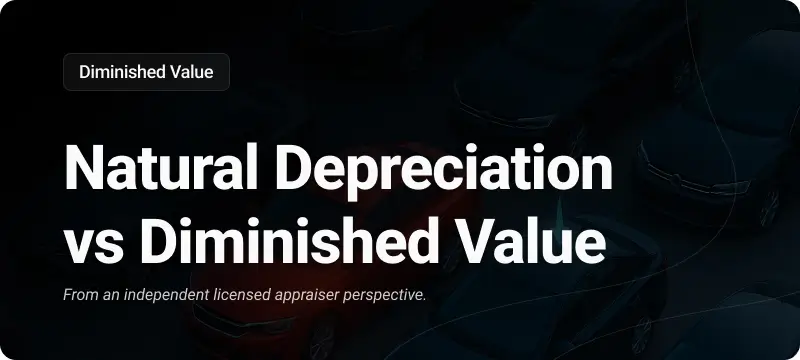Do market factors in diminished value claim change the outcome of your insurance payout? When you file for diminished value after an accident, the broader market plays a key role in determining how much compensation you actually receive. In this article, you’ll learn how supply and demand, regional car prices, seasonal trends, and economic conditions all influence your diminished value estimate. By the end, you’ll know what factors insurers consider, how to use market data to your advantage, and what steps can strengthen your claim.
Understanding Market Factors in Diminished Value Claim
A diminished value claim compensates you for the loss in your vehicle’s resale value after repairs. Even if repairs are perfect, buyers often pay less for a car with an accident history.
Market factors influence how insurers decide what that loss is worth. These include:
- Vehicle popularity in your area
- The overall used car market
- Economic trends like inflation or interest rates
- Seasonal shifts in buyer demand
The Main Market Factors That Impact Your Claim
1. Used Vehicle Supply and Demand
When demand is high and supply is low—such as during certain economic conditions—your car’s diminished value might be less severe. In contrast, when the market is flooded with similar cars, your loss may be higher.
2. Seasonal Market Shifts
Sports cars often sell for more in summer, while trucks and SUVs may do better in winter. Timing can make a real difference in your appraisal.
3. Economic Conditions and Inflation
During inflation, replacement costs rise, which can change both repair values and resale prices. This affects the baseline used to calculate diminished value.
4. Regional Price Variations
The same make and model may have different market values in different states or cities. Local demand plays a big role.
5. Brand and Model Popularity Trends
If your car’s brand has recently gained or lost popularity—due to recalls, new models, or reputation shifts—this will factor into its diminished value.
How Insurers Apply Market Factors to Your Claim
- Adjustments to the 17c Formula – Many insurers tweak depreciation percentages based on current market data.
- Regional Comparables – They may use local listings rather than national averages.
- Trend-Based Reductions – Some companies lower payouts if they think the market is weak for your type of vehicle.
Strengthening Your Case Against Market-Based Reductions

- Get a Professional Appraisal – Independent experts can counter insurer estimates.
- Use Real Market Data – Bring in listings from trusted sources that reflect your local conditions.
- Challenge Unfair Adjustments – Ask for written proof of the market data the insurer is using.
Common Mistakes to Avoid
- Accepting insurer calculations without checking them
- Ignoring seasonal or regional price trends
- Not collecting your own comparable sales evidence
Case Study: Market Conditions Changing a Claim Outcome
In 2023, two drivers with the same model car and similar accident damage filed claims in different markets.
- Driver A lived in a city with low SUV supply, receiving a smaller diminished value deduction.
- Driver B’s region had a high supply of similar SUVs, resulting in a much lower payout.
| Scenario Type | Vehicle Type | Market Demand Level | Supply Level | Impact on Diminished Value | Example Payout Change |
|---|---|---|---|---|---|
| Owned Vehicle – High Demand Market | SUV / Pickup | High | Low | Lower DV percentage | -10% from baseline |
| Owned Vehicle – Low Demand Market | Sedan | Low | High | Higher DV percentage | +15% from baseline |
| Non-Owned (Lease) – High Demand Market | Luxury Sedan | High | Low | Slightly reduced DV | -5% from baseline |
| Non-Owned (Rental) – Low Demand Market | Economy Hatchback | Low | High | Increased DV impact | +20% from baseline |
| Commercial Fleet Vehicle – Stable Market | Cargo Van | Medium | Medium | Average DV impact | Baseline |
| Seasonal Demand Shift (Sports Car) | Convertible | High (Summer) | Low | Lower DV in peak season | -12% from baseline |
| Seasonal Demand Shift (SUV) | SUV | High (Winter) | Low | Lower DV in peak season | -8% from baseline |
Conclusion: Navigating Market Factors in Diminished Value Claim
Market conditions can either help or hurt your diminished value claim. By understanding these factors and preparing strong evidence, you can push back against lowball offers. Remember—your car’s value isn’t just about damage; it’s about timing, demand, and regional trends.
If you gather the right data and present it clearly, you stand a better chance of securing a fair payout.



